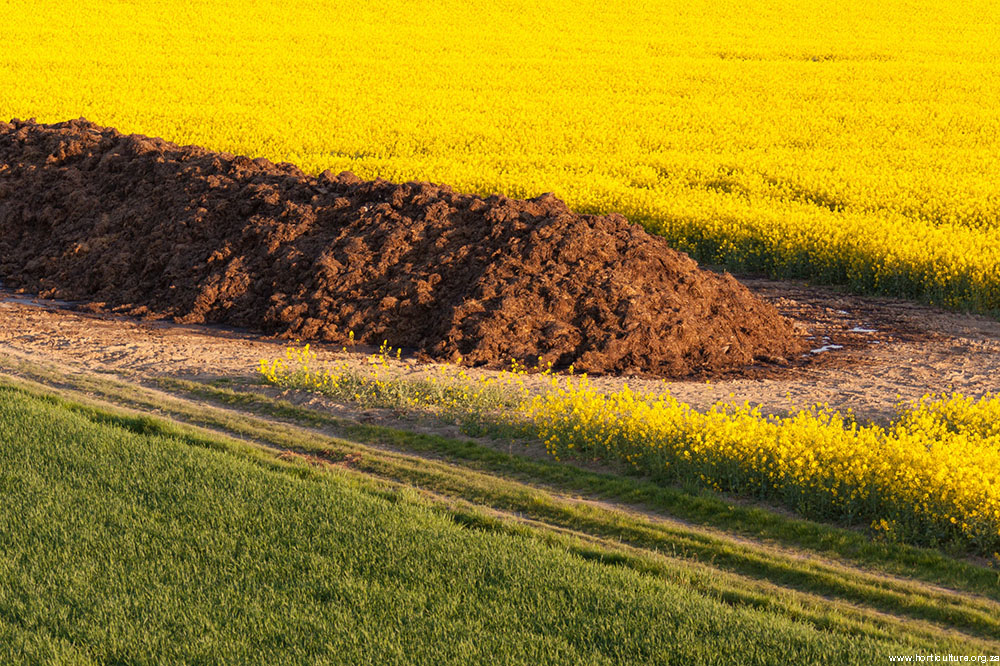
Manure – a technical discussion
Manure is the waste from animals. Farmer’s source manure either from natural deposits or livestock farmers. The content of manure is highly variable, and each batch must be analyzed when used for nutrient analysis for crop growth. We recommend reading Natural fertilizers for vegetables with this article.
Manure is different from compost. It cures and removes natural material such as cellulose, hemicellulose and sugars. The curing process retains as much humic acids and nutrients as possible. To achieve this, the green animal waste, green manure, is compacted on a heap so that anaerobic (Anaerobic conditions are oxygen-deprived) conditions exist. The biggest problem in maintaining a rich nutrient content in manure is nitrogen. Mineralization of various proteins and hydrolysis of amides creates ammonia salts. These salts are especially volatile dissolvable ammonium carbonate (NH4)2CO3.
Manure heaps left in the open cause loss of nutrients through leaching and evaporation. Leaching can be prevented by covering it with plastic or placing it in a barn. If the manure gets too dry, many of the valuable nitrogen nutrients evaporate since the original molecules become volatile. Adding superphosphate solves the problem. Superphosphate converts ammonia carbonate to non-volatile and stable phosphate and sulphate. This process reduces nitrate leaching, but it also converts the water-soluble phosphate to unavailable tricalcium phosphate.
No oxygen is present during the curing process. That is called anaerobic conditions. If, however for some reason the pile becomes oxygenated, the conditions turn aerobic. The oxygen causes nitrification of the ammonia, which leaches out quickly. What is worse is if the manure gets wet after it dried out. Large amounts of nitrogen evaporate in the form of N2 and N2O, both nitrogen gasses.
As the manure cures, its volume shrinks through carbon loss and the concentration of nutrients increase. Manure from sheep has less roughage than cow manure, so the curing process is slightly different and faster. In some cases, manure from sheep grazed in arid areas such as the Karoo have a high concentration of sodium, which can lead to an increase in soil pH.
Animal waste converts to manure. Farmers source it either from natural deposits or livestock farming. The content of manure is highly variable, and each batch must be analyzed if used for nutrient supply for crops.
The most common sources of manure are guano, poultry farms, bat caves, dairies and sheep farms. The content of the different manures is in the table below.
| Manure type | % Moisture | % N | % P | % K |
|---|---|---|---|---|
| Guano | ± 15 | 7 - 11 | 4 - 6 | 1.5 - 2.5 |
| Chicken manure | ± 35 | 1.7 - 2.8 | 0.5 - 2.0 | 1 - 1.5 |
| Bat manure | ± 15 | 5 - 14 | ± 2.5 | ± 1 |
| Cow manure | ± 65 | 1 - 2 | 0.2 - 0.5 | 1.5 - 2 |
| Sheep manure | ± 20 | ± 1.5 | ± 0.25 | ± 3 |
Guano
Guano came originally from the Spanish work bird manure and sold as a fine white powder with a strong smell of ammonia. As been mentioned before, the content differs from year to year. 75% of the nitrogen in guano is in the form of urea (carbamide)(CO(NH2)2), ammonia carbonate (NH4)CO3), ammonium sulphate (NH4)2H2PO4) and uric acid. Guano is popular because all these compounds are readily available to plants at the time of application. Because of the high concentration of nutrients and especially the ammonia component, it is mostly diluted and used as a top dressing. The other 25% is in the form of proteins that mineralizes slowly over time. The slow mineralization makes guano a good slow-release fertilizer of nitrogen.
Vegetable farmers mix guano with other manures or compost to balance out the nutrients. The ammonia content of guano is too high for seedlings. A typical recipe for guano in vegetable farming would be in the ratio of 10:0.3:0.2 t/ha – compost to superphosphate to guano.
Chicken manure
Chicken manure is becoming popular because of the growth of that industry. It has significantly less nitrogen and phosphorus than guano, but overall, it is the same. The content of chicken manure can differ depending on how much another organic material is incorporated. Common materials with which it is mixed are sawdust and hay. Apply chicken manure at 2-5 t/ha to the soil.
Bat manure is like guano but releases nitrogen slower than chicken manure. In some cases, bat manure is sold more for its phosphate content than nitrogen.
The nutrient content of manure depends on:
- The ratio of manure to urine
- The feed type and its content
- The age of the animals
- The age of the manure
- The type of hay or straw used on the floor of the barns which get mixed with the waste
- The treatments applied to the manure during curing





